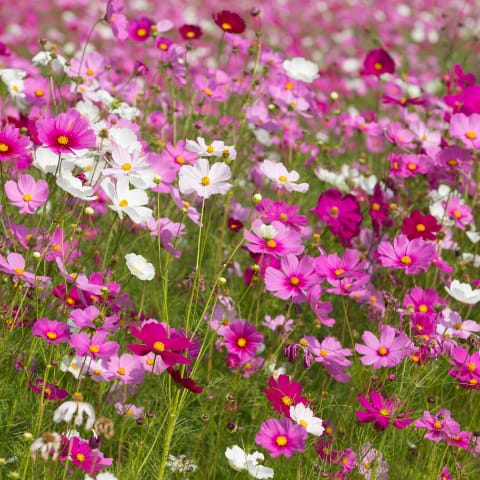Nothing in Basket!



Sow Rate: 3 gram of seeds per meter square
Loved by Bees and Butterflies
Shipped within 1 to 3 days.
Position: Full sun.
Soil: Moderately fertile, moist but well-drained.
Sow: Direct in May. Indoors March to April
Size: 1 to 3 feet
Colour: Crimson red, Rose, White
Description
Choose our mix of floriferous cosmos for a cheerful display of bright colour all through the summer. With long, slender stems and attractive ferny foliage and a plentiful crop of pretty daisy-like flowers, this easy-to-grow, sun-loving annual thrives on moderately fertile, well-drained soil. It also makes a very good cut flower.
Sow in March or April for a profusion of blooms right through the growing season.
Sowing cosmos seeds undercover
Cosmos seeds can be sown undercover in March or April. The seeds are long and thin, so can be easily handled.
Use seed trays filled with good compost. Push two seeds about 3mm deep into each module. Water well and then place in a greenhouse or on a warm windowsill to help germination. If both seeds germinate, remove one of the seedlings a week later and leave the other one to grow on.
Pot the seedlings on into larger pots when they are big enough to handle. Pinch out the growing tip of each stem when 3 pairs of true leaves have grown to encourage stems to branch and produce more flowers. Then plant out in late May or June once the risk of frosts has passed.
Direct sowing cosmos seeds
Direct sow your cosmos seeds in May - the risk of frost should have passed by the time they emerge.
Prepare the soil before planting. Rake the patch until you have a fine, crumbly consistency. Space the seed about 5-8cm (2-3in) apart and water well.
About three weeks later, the seedlings should have popped up. At that point, you can thin them out to about 30cm (12in) apart. Pinch out the growing tip of each stem to encourage them to branch and produce more flowers.
Sowing withing a wildflower bed scheme
Sowing Rate
See individual product page for sowing rate. Increasing this rate may result in some species out competing others and reducing the rate may result in weeds or grasses dominating. *Tip 1 level teaspoon of wildflower seed is about 1.5g
Flowering Period
Annual species sown in Spring will bloom 8-10 weeks after sowing. Annuals sown in Autumn will bloom the following summer. Perennial species begin to flower the second year after sowing. If managed correctly, these flowers will return year after year.
Ground Preparation
Prepare pots or a bare seedbed in advance of sowing, free of weeds, grass, and other plants so that the wildflower seeds don't have to compete with other plants. This step is essential to establish wildflowers successfully.
Sowing
Maintenance
Cut the plants back to 7cm in height after flowering in the autumn. Remove the cuttings to keep soil fertility low and to not smother emerging plants. Do not apply fertiliser or plant food.
This Seed Contains No Filler
Mix with a Carrier such as sand, sterile compost or Ready Brek to bulk the seed for a more even broadcast.
Nothing in Basket!